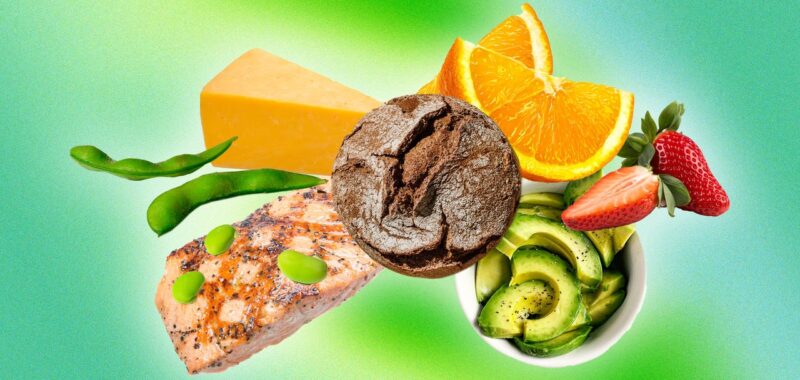Diets have a bad reputation—deservedly. They tend to be hard to sustain, and are often based on a passing obsession with celery. Or chicken soup. Tracking macros, however, is not a diet. No, it’s eating with purpose; deciding your goal—fitness or otherwise—and counting the food you need to eat to achieve that goal.
There are three macronutrients: protein, fats and carbohydrates. How many of each you need depends on what kind of body you’re after, where you are right now, and what kind of training you’re doing. (Vitamins and minerals are micronutrients—they matter too, but this is about pulling the big levers.)
Each of the three macros serves a different function. Protein (eggs, meat, chicken fish, beans) is needed for muscle growth and tissue repair. Healthy fats (olive oil, nuts, avocado, fish oils) are important for energy levels and cognitive function. Carbs (brown rice, pasta, and bread) are the primary energy source. The macro-tracking approach involves care, discipline and one of those little scales that serious foodies have nestling next to the yuzu fruit.
Joseph Rapoport, 28, has a stressful job in real estate and as a consequence was dipping in and out of exercise. Under the guidance of Samuel Quinn, the personal training lead at Nuffield Health, he began working out regularly and adopted macro tracking. He started out at 176 lbs with a goal of bulking up: He pushed his weight up to 192 lbs and achieved 12.5% body fat. He then changed his macro targets with a new goal of cutting fat, and now has eight percent body fat and weighs 163 lbs. Rapoport feels macro tracking changed his life, and his story illustrates the power of the technique if you’re willing to really commit.
A fresh start
“My initial motivation was to see how big and strong I could get, “ he says, ”but my goal changed over time. I live in Bristol, England but I moved to Plymouth to start a business and because I was living on my own, I had a lot of time outside of work to actually focus on something. I wanted to see what I could achieve. I’d toyed with fitness in the past, done the odd gym session, but never really properly focused on it.”
Nutrient targets
“I always ate healthily, but you have to be eating the right thing across the balance of nutrients. The more I did it, the more obsessed I became with it, re-evaluating my meals to make sure I was hitting the goals. My trainer Sam said it was some of the best tracking he’d seen. I was weighing every tomato.”
Daily macro breakdown
“My daily calorie intake was based around protein. In the initial muscle-building phase I got up to 192 lbs. by eating 3200 calories a day made up of 160 grams of protein, 400 grams of carbohydrate, and 107 grams of fat. Sam explained how many calories there were in each macronutrient: four calories per gram of protein, four for carbohydrate and nine for fat.”
Weighing every meal
“I was vegetarian at this time, so I was eating a lot of eggs. The other two macros, fats, and carbs were basically whatever I had left. We didn’t count fibrous vegetables at all—broccoli, zucchini, salads. I could eat as much of that as I liked, within reason. I had the scales out for every meal, which at the start is very time-consuming, but after a while, you get to know the breakdown. It feels fairly strenuous at the start but becomes a lot easier. It makes eating out more difficult but you can look meals up. Also, it’s about consistency: I was pretty consistent during the week so I didn’t mind going out for a meal or having a glass of wine on the weekend. If I did that on Saturday, I might just drop my calories slightly on the following day.”
A typical day
“A breakfast of natural yogurt with nuts, while lunch or dinner was 4-5 scrambled eggs, whole-grain toast, some vegetables, pine nuts and seeds with olive oil, and guacamole. I also used protein shakes. Now as I’m no longer vegetarian, it’s baked salmon with butter, garlic and lemon or chicken breast with a honey and garlic glaze. I found all my own recipes and experimented.”
New goals
“I really enjoyed tracking my progress. I’d say start small, over time it actually becomes an interest rather than being another stress. It’s been nice to have something that means my life isn’t just focused on work. I’m taking it to the next level now, cutting my body fat. My current macro goals are 1930 calories per day made up of 193 grams of protein, 145 grams of carbohydrate, 64 grams of fat.”
Mental health benefits
“I’ve never felt this good and this focused with such mental clarity. I find work less stressful—the core job hasn’t changed, but I don’t feel stressed by it. I feel more confident and more articulate. The effect it’s had on my mental health has been one of the biggest difference—it’s incredible.”
This story originally ran in British GQ.

